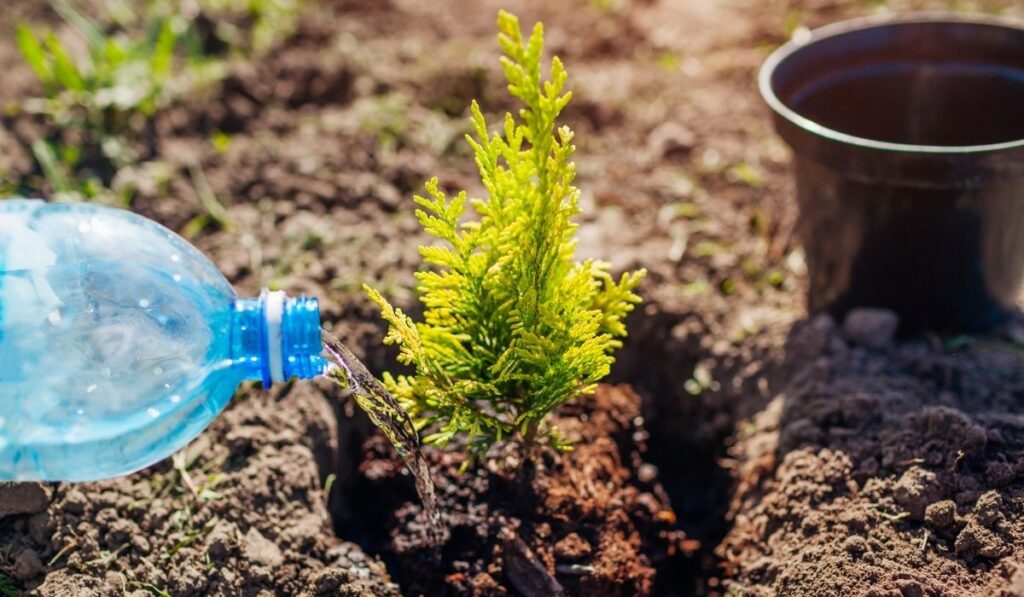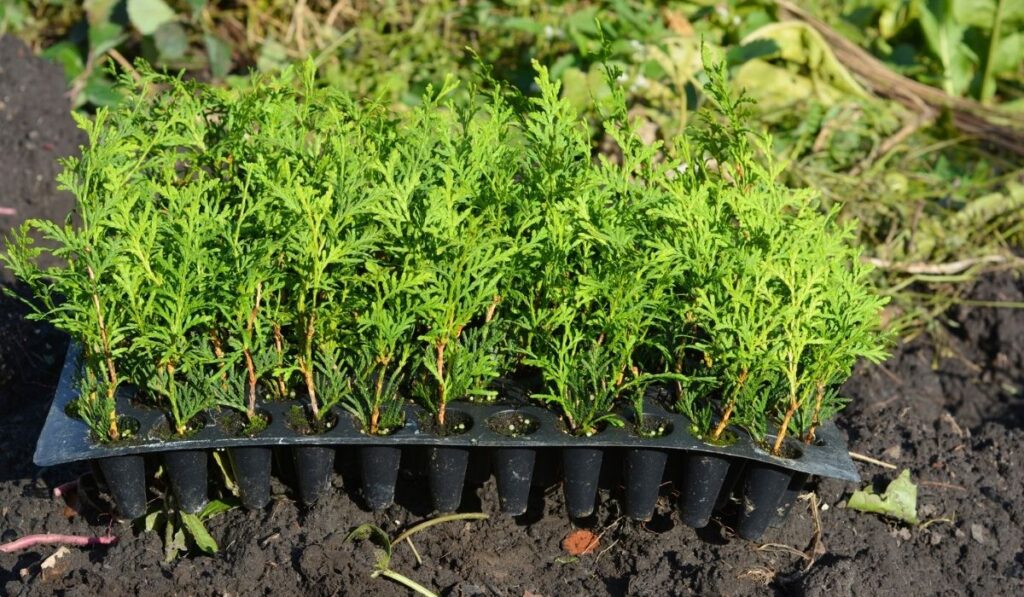If you’re searching for a tree that is reasonably easy to maintain and delivers beauty throughout the year, then an evergreen tree might be precisely what you’re looking for. Here’s everything you need to know about planting evergreen trees.
The best time to plant evergreens is early spring or early fall. Before planting, consider how big the tree will get, and choose a location accordingly. You don’t want it to rub against a structure or wall. Water your evergreen throughout the dry seasons, and mulch around the tree liberally.
Let’s take a closer look at the benefits of having an evergreen tree, the most common types, when to plant one, and how to maintain your tree’s health throughout the year.
Why You Should Have an Evergreen Tree

As opposed to deciduous trees, which shed their leaves each fall, evergreen trees retain their foliage throughout the year. Evergreens are also renowned for their resistance to cold weather.
Evergreen trees aren’t just used for landscaping color, though. Here are some of the other interesting things you can do with evergreen trees on your property:
Wind Protection
In addition to providing year-round beauty, evergreen trees provide wind and snow protection for our homes. When we’re outside, the wind chills our bodies. When we’re inside, the wind also steals heat. A buffer of evergreens can shield a property from chilly winds and reduce heating costs.
Barrier From Snow
Usually, snow fences are installed to prevent blowing and drifting snow, which can obstruct driveways and close roadways. Evergreen trees can be planted to create a living snow fence as an attractive alternative to traditional fencing, which can sometimes be pretty unsightly.
Many of the trees that were initially planted as living snow barriers in the early 1900s to protect railroad lines and key highways are still doing their job to this day.
Air Quality
As the planet’s lungs, trees work tirelessly to purify the air by exchanging carbon dioxide for oxygen. During the summer, our deciduous trees play an essential role in protecting yards from the pollutants and smog that could make their way into homes.
However, during the winter, when air pollution is at its greatest, these trees’ protective capacities are significantly diminished.
When Should You Plant Evergreen Trees?
Early spring is the ideal time to plant a containerized tree so that it will flourish for a complete growing season. It will also reduce transplant shock if the plant isn’t planted during the summer. Fall plantings are also ideal, but root development may be hampered when the ground freezes.
Evergreens can be planted virtually anytime; however, there are optimal planting periods. The optimal time to grow an evergreen conifer is very early spring, after the earth has thawed and frost has melted.
Evergreens will thrive during establishment in chilly spring conditions with abundant precipitation. You can keep planting evergreens well into spring if you provide them with ample water.
Early fall is also a good time to plant evergreen conifers, giving at least six or eight weeks before the soil freezes. The evergreen will have the fall and early spring to gain strength before suffering the summer heat, which is more taxing on the plant than the winter weather.
Be sure to give the ground a good soaking once a week until it freezes, and mulch liberally to prevent the soil from shifting too much as the temperature fluctuates between freezing and thawing.
Different Types of Evergreen Trees
Evergreens have their own special allure. Solid and stable, they make sure that your landscape retains its visual appeal during the winter months.
When the weather turns cold, they also offer birds and other tiny animals a safe haven — the foliage of these trees always provides a refuge for animals of all sizes, regardless of the season.
Numerous plant types are thick enough to shield your property from the wind’s worst effects. They can also have a striking look, with some attaining astonishing size and coloration. The following are the best evergreen trees you can cultivate:
Douglas Fir
This tree typically grows alone, although a group of them can still be a beautiful sight. It grows needle-shaped leaves directly from its branches. It has blue-green or yellow leaves that dangle singly on the branch. The Douglas fir may reach heights of up to 80 feet and is an excellent addition to any landscape.
Pinyon Pine
It can take a pinyon pine tree up to sixty years to reach its mature height of seven feet, even though it’s an evergreen. It’s also highly durable; it can survive over 600 years. Its two-inch-long, yellow-green needles can remain on the tree for up to eight years.
Thuja Green
When a big privacy screen or windbreak is required, Thuja Green Giant is the ideal option due to its rapid growth, resistance to all weather conditions, and ability to reach maturity in a short amount of time. It’s always the perfect shade of deep green and so attractive that it should be the top option for a massive hedge. This tree also grows very quickly — between 3 to 5 feet per year.
Norway Pine
This evergreen tree is sometimes referred to as the red pine. Certain Norway pine varieties have drooping branches, which can give the impression that the tree is crying.
Other species of Norway pine used in landscaping include a conical shape with outwardly curved limbs. These are cold-tolerant pine trees that thrive in full sunlight and acidic soil.
How Do You Plant Evergreen Trees?

Let’s find out how to plant evergreen trees so that you can get the best results!
Choose and Prepare the Location
Spend time determining where to plant your tree before rushing into the planting process. Consider the plant’s need for sun or shade and position it accordingly in your garden. Think about how broad it will get, and give it enough room to expand away from structures — buildings in particular, but also walls and fences.
When it comes to growing a tree, proper soil preparation is essential. Whatever your soil is like, use it. Don’t attempt to dig a hole and fill it with soil purchased elsewhere. If your soil is deficient, simply add more organic matter.
The objective is to create a huge area of looser soil that young roots can easily penetrate, absorbing nutrients and establishing themselves rapidly. You’ll need to dig as deep with your shovel to cover an area that’s at least three times the pot’s diameter. As you dig, incorporate some organic material into the soil.
Plant Your Evergreen Tree
No fertilizer or soil improvements should be added. Raise a mound of earth 3 to 4 inches high in the center of the hole, then set the center of the root mass on top of the mound, spreading the roots out in every direction around the planting hole. Immediate filling of the hole is required.
Construct a 3-6 inch high earth dike along the perimeter of the root zone. This will collect water over the roots as it percolates through the soil. To retain soil moisture and discourage weeds from sprouting, lay 3-6 inches of organic mulch over and around the root zone and beyond.
Put the mulch or other organic material at least 3-4 inches away from the trunk.
Maintaining Evergreen Trees
The year-round greenery and beautiful aspects of evergreen trees and shrubs are part of what makes them popular. When they’re planted in the appropriate location, care needs can be minimal. Most evergreen trees need regular watering, mulching, occasional fertilization, and pruning.
Fertilizing
Fertilization may be beneficial if development is sluggish or the leaves or needles don’t have the typical appearance. Mycorrhizae, a helpful fungus, and the fertilizer will help the evergreen take the nutrients more effectively.
Mulching and Watering
Maintaining soil moisture is necessary for evergreen trees to endure winter or drought. Wood chips or powdered bark mulch around a tree’s drip line (the area just outside its canopy) reduces drainage from the soil.
Combine mulch with compost or other organic debris to enrich the soil with nutrients. Water the tree throughout the dry seasons in the summer and fall, and if you live in a region where the ground doesn’t freeze, water it in the winter as well.
Conclusion
Your evergreen tree will need regular watering until it’s established and has spread its roots. If it’s hot outdoors, you may want to do it twice a week, but this will depend on the weather. Soak the tree’s entire vicinity, not just the part closest to the trunk.
There you have it! Your new evergreen tree is well on its way to a long and fruitful life, and you can expect it to provide you with lush, healthy leaves throughout the year. It’s worth it to take a little extra time and make sure you get it right when it comes to planting evergreens.
